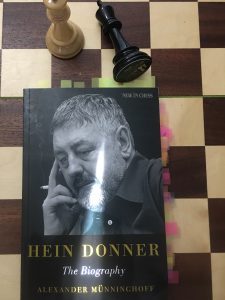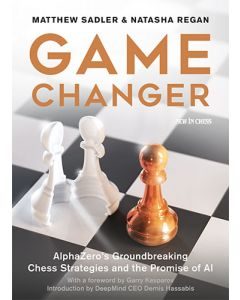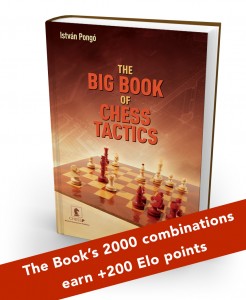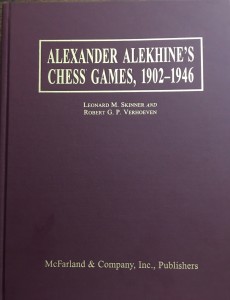Hein Donner the Biography
Hein Donner the Biography by Alexander Münninghoff is a book on the intricate life of Dutch chess Grandmaster Hein Donner. Münninghoff was able to write about a chess Grandmaster with a complex personality and different interests in life in under three hundred pages. The book starts with the description of the first Donner to enter the Netherlands in the XVIII century, Gottfried Otto Donner and continues until the reader gets a clear picture of the Donner’s role in Netherland’s chess and cultural history. In literature, Donner won the Henriëtte Roland Holst prize for his work “Written after my death” typing the whole time with one finger after suffering a stroke.
Münninghoff crafts Donne’s biography with just the right amount of details to help the reader to get an evolving image of Donner at different points in his life. As a result of the author’s writing style, Hein Donner the Biography has an exquisite fluidity and a marvelous use of space. In consequence, the book engages the reader’s attention and help him to understand the life of a complex man. The logical consequence of Münninghoff’s work is that Hein Donner the Biography, is a pleasant work for readers with non or scarce chess background in addition to chess players. Non chess players can enjoy the story line and the multiple turns and situations that slowly develop Hein from a chess Grandmaster into a laureate writer.
I like the way the author uses some of Donner’s chess games to create context for the Biography, but are not the main topic of it. Actually, the fact that the games are presented with (quoted) light annotations engage the diligent reader to dig deeper. For example, in the game Donner – Euwe, Winterswijk, 1943, I was puzzled how Euwe survived the opening and end up winning the game. In the notes to this game, Tim Krabbé, gives” with 14.Nxc4 White could have obtained good chances. Now he gets slowly forced onto the defensive”. As a class A player, I sensed that 14.Bc4 is not a bad move, you deploy your strongest minor piece to the most active diagonal and prepare to castle. I continue going over the game and felt how Euwe can get away with turning the tables in this game and win an instructive knight endgame? The game was stuck in my head until the chess engine stock fish 10 helped me to understand the position. Euwe creates a counter play not because of 14.Bxc4 was wrong, but because he failed to play 15.Bb5+ and force the Black king to e7. Now Euwe’s play along the f file takes one extra move and his king will be in danger in the center.
I am happy, Hein Donner the Biography brought to my attention some instructive games, such as the game mentioned above and the game Cuellar – Donner, 1972. The later game played at the Olympiad the Colombian IM uncorked the stunning exchange sacrifice 64.Bxc5! The game ended in a draw after more than one hundred moves and the accusation by Donner that his opponent touched a piece and did not move.
The best way I can describe Hein Donner the Biography is by comparing the book to a high end Voutilainen watch. Both, are unique, functional and contain an intrinsic beauty in the way all the components work in harmony, with economy and without redundancy. Münninghoff’s work is a welcome addition to previous efforts about the life of Hein Donner, such as the book The King by Krabbe and Pam. As I read Hein Donner the Biography, a plethora of feelings arose in me such as the pleasure of enjoying a well written book, the curiosity of learning about chess in the Netherlands after Euwe and before Timman, the sadness after Donner’s death at an early age and finally, inspiration as I reflect on Donner’s passion for his work until the really end.
Hein Donner the Biography is a distinct book that will bring pleasure to the reader, regardless if he plays chess or not. A must read.
Game Changer
Matthew Sadler and Natasha Regan’s Game Changer is a book worthy of its title. The authors tell the story behind the development of AlphaZero, a self-taught chess machine that convincingly beats Stockfish 8, a strong open-source chess engine that relies on brute calculation power and the evaluation of preconceived parameters provided by a human. The human-like way AlphaZero plays chess makes this self-instructed device a real “game changer” in fields beyond artificial intelligence (AI) and chess.
The story behind a ground-breaking event like the development of AlphaZero and an analysis of its games requires a special type of writer. Fortunately, Sadler and Regan are a team with the rare combination of expertise in multiples areas and an ability to analyze and summarize a large amount of data (games) in an engaging style, while still instructing and inspiring the reader. They have written a fluid and absorbing book that is, at the same time, as logical and rigorous as a good scientific manuscript.
Their previous work Chess for Life, the English Chess Federation 2016 Book of the Year, is based on interviews with and case studies of Grandmasters who have continued to play well into middle age, including Sergei Tiviakov, Judit Polgár, and Yasser Seirawan. Using a similar technique in Game Changer, Sadler and Regan interview the AlphaZero developers and query a pool of chess engines while analyzing Alpha Zero’s games. Remarkably, Sadler, a grandmaster and IT consultant, was able to keep pace working on hundreds of chess games (and recalling similar games played by humans) using a “ breakneck speed method,” while asking the traditional chess engines relevant questions to illustrate the differences between AlphaZero and traditional chess programs and determine what positions were worth to force AlphaZero to play. WIM Regan, who also studied mathematics at the University of Cambridge, synthesized this data in tables and charts that allow the reader to understand the differences between AlphaZero and Stockfish 8 as well as the authors’ conclusions.
An underestimated value of Game Changer is its ability to inspire the reader to undertake challenging projects (as the authors did) and to learn to play chess. Although many reviewers have opined that Game Changer is primarily geared toward advanced chess players or AI scientists/enthusiasts (some even believe that only experts will get the most out of this book), I would argue that if a self-taught machine can excel at chess, then why can readers not learn chess on their own while enjoying this fascinating book? In the grand tradition of General Chemistry by two-time Nobel Prize laureate Linus Pauling, Game Changer makes a complex subject more accessible by pairing Sadler and Regan’s expertise with a relentless effort to educate the reader using an original presentation style. Highly recommended! (Review by Miguel Ararat, edited by Kate Casey Sawicki)
Vera Menchik
A Biography of the First Women’s World Chess Champion with 350 Games
by Robert B. Tanner
Vera Menchik a Biography of the First Women’s World Chess Champion with 350 Games is the latest effort by Robert B. Tanner. The author wrote a biography of the first Women’s world champion Vera Menchik plus all her games available at the moment. This work on the life and games of Vera Menchik fills a major gap in chess literature in the English language. In the past, only scattered games without historical context were available about Vera Menchik’s chess career. The book is a recommended choice to parents looking for an inspirational read to motivate female chess players at the K-3 level, players interested in positional chess or chess history. Finally, the chess games and annotations in this book can be use as chess training material, especially, the handling of closed positions by Menchik and her opponents are particularly useful.
I am a coach with an interest in chess promotion among female chess players. A book in English on the career of a strong female chess player with a classic/positional style and deep core values that can be use as a role model was a pressing need. Vera Menchik A Biography of the First Women’s World Chess Champion with 350 Games provides chess students with a book that explains the conditions the first women world champion endure at a time of male dominance in the chess scene worldwide. Tanner’s work shows how a female chess player can overcome obstacles from society, chess peers and ill intended journalists with a positive personality, good results over the board and hard work. Tanner was able to write a book that clearly connects Vera’s development as a chess player with other leading female players of that time such as Mary Rudge and Sonja Graf. Together, the author shows why Vera Menchik was such an important figure in the popularization of chess among women and gives the first woman World Chess Champion the place in history she rightly deserves.
Vera Menchik’s chess style was positional, but with a display of energy and drive. It is not a surprise that a strong positional player like Erich Eliskases was interested in publishing Vera’s gamesThe Times. Eliskases was a strong Austrian chess player that won twice the German Chess Championship (1938 and 1939) and was part of the German team that won first place at Buenos Aires 1939. After the II World War broke in 1939, Elikases decided to stay in Argentina and become a leading chess figure in this country and South America. In 1943 Eliskases published the book on positional chess “Decalogo del Ajedrez Positional”, a book that influenced the positional chess understanding of generations of chess players in Spanish speaking countries. That being said, it is not a surprise Eliskases was impressed with Vera’s positional play and submitted her games with annotations to the chess columnist of The Times, E.S Tinsley in July, 1936. Tinsley’s biased and unprofessional reply was an example of the unjustified treatment Vera endures from a segment of journals worldwide. In contrast, the annotations about Vera’s chess in the tournament book Moscow 1935 are more objective, despite Vera’s poor results.
About the tournament Moscow 1935. Tanner suggested that Vera’s poor performance was influenced by factors no related to chess, but after looking at the book tournament an alternative explanation may be possible. I founded that Vera’s initial games showed an unusual degree of sharpness even as black against Botvinnik in game three (12…Nd4! 16…Qd6!) but as the tournament progressed and Vera did not score, she played less active and more conservative. In the rest of the tournament Vera consistently avoided to raise the level of sharpness of her chess even if the position on the board demands it. Vera’s opponents took advantage of her lack of dynamism to prevent her from scoring more points. For example, against Goglidze (9…Bb7 when the sharp 9…c5 will provide enough compensation for a pawn with an unbalance struggle ahead) and versus Pirc as white ( 14.Rc1?, 14 g4! with an attack against black’s king). All the evaluations were taken from the tournament book. In any case, I think that some chess authors used Vera’s results in this tournament to sell the wrong idea about her true chess strength. If you go over the list of players in Moscow 1935 with attention it is clear that the best players of the world were there and that at any tournament someone has to be last.
As a chess coach, I find difficult to find modern chess games to explain positional concepts to very young players. Current chess praxis is fueled by computer assisted preparation and the nature of the game is way to concrete. A novice chess player may find taxing to grasp positional concepts in a pure form from a contemporary master game. After going over Vera A Biography of the First Women’s World Chess Champion with 350 Games, I founded that Vera’s games can be use to illustrate basic positional concepts in a pure form and that even her games prove to be a source to study the development of opening ideas! (some variations used by Vera Menchik still relevant today) Let’s take for example the game Menchik- Lasker, Moscow 1935. In this game after the sequence 1. d4 Nf6 2.Nf3 d5 3. c4 e6 4. Bg5 Nbd7 5.e3 c6 6.Nc3 Qa5 we reach the sharp Cambridge Spring variation of the Queens gambit declined. Vera’s choice was Bxf6 a move aimed to prevent black freeing moves c5 and e5. The same idea was played against my by Jorge Oquendo, a Cuban master that immigrate recently to the US (Oquendo, 2400 – Ararat 1880, Daytona Beach 2016). Oquendo used the same idea than Menchick employed against Lasker to prevent me from breaking free and slowly outplay me. In other words, the chess coach will find in Vera a Biography of the First Women’s World Chess Champion with 350 Games, a rich source of model games to teach positional chess to novice and intermediate chess players. This book is highly recommended and a must buy to parents and players below 2000 USCF level that struggle with positional chess.
Vera Menchik A Biography of the First Women’s World Chess Champion with 350 Games (McFarland, 2016) can be purchased at www.mcfarlandpub.com or at 800-253-2187
The Big Book of Chess Tactics
By Istvan Pongo
Istvan Pongo is best known in the US by his book Tactical Targets vol 1 and 2, cited in the bibliography of the la Maza’s book rapid Chess Improvement (2002). This time the author aims to deliver a comprehensive book on tactics on one volume as an improved version of the two books mentioned above. The book is almost eight hundred pages long (but it does not feel heavy), hard cover, printed in high quality paper, has a red and yellow built in page markers and the page binding is sturdy. In other words, this book is a pleasure to hold and work with. The pages have two diagrams at the top of the page and the answer below the diagram, so the reader can solve the puzzle and cover the answer with a piece of paper or just focus on the diagram and avoid looking down the page. This format saves time because the reader does not need to flip pages back and forth to find the answers the exercise pages have six diagram per page.
The book is conceived following three principles, First that all the combination comes from previous games (Tal’s statement on tactics “It is unlikely that a new original combination occurs in the present stage of advance chess”). Second, that to be successful at chess a player needs first to identify the a tactical opportunity and third, after the opportunity a.k.a tactical target is identified the player needs skill to checkmate his opponent, gain a decisive material advantage or save a lost position by perpetual check or stale mate. Additionally, the chess player needs a simple but important understanding of the types of balances in chess in order to carry out a successful tactical operation and understand chess better as a whole. The book has short remarks about the career of several chess masters and tactical tips which make the book more entertaining and less dry than the Encyclopedia of Chess Combinations.
Tactics are grouped around twenty three motifs and explained with almost two thousand examples with solutions. The first theme is the double attack, the easier topic to master and the one that delivers the most victories at the early stages of any chess trainees. The double attack is without doubt a heavy point scorer tool at all levels of chess, from beginners to seasoned grandmasters. Pongo’s experience as a teacher can be trace back to the way the examples are presented, from just “observe and find” to systematically force your opponent’s pieces to ‘be in the right squares”. At the end of this chapter and the rest of the book the reader will enjoy masterpieces of tactical ingenuity. The combinations are instructive and pose a good challenge to the ambitious chess player.
This is so far the best book on chess tactics I came across in many years for several reasons. First, the books follows a systematic approach following the intrinsic elements of the theme at hand, instead of presenting the subject matter, as a single generic topic like “pins” or forks. Second, the book is structure in a way that can be used to teach chess tactics at a different levels of chess development. The examples are pure joy to go over them and enjoy the creativity of chess players. Finally, the book is a very high quality product, a lot of attention to detail and build to last.
Review 3
Alexander Alekhine’s Chess Games, 1902-1946
By Leonard M Skinner and Robert G.P Verhoeven
Alexander Alekhine’s Chess Games, 1902-1946 by Skinner and Verhoeven is the most comprehensive collections of the forth world chess champion Alexander Alekhine (1882-1946).This book belongs to the library of every chess enthusiast. The reasons to support this claims are the following. First, Alekhine was a strong player and superb annotator with a passion to explore the resource available to both players during his games. Second, Alekhine was a strong correspondence chess player before becoming a top over the board player which makes Alekhine’s games (especially the early games) and analysis a good blend of home analysis and practical advice to play opponents face to face. In other words, Alekhine annotations mix theory and practice. Third, Alekhine was paid to annotate chess games for newspapers and chess magazine of good reputation as a result Alekhine’s comments on a chess game were high standard and produce to educate a wide audience at the same time that his work will stand the review of his peers. Fourth, The games of the forth world chess champion are high quality and good models in all the three phases of the game (M. Marin, makes a good argument that some of Alehine’s games reached a rare fourth stage of a chess games) which make this game collection a complete “one stop” resource to any player looking to improve his/her chess skills. Finally, all the coaches I worked so far including Cuban GM Amador Rodriguez (youngest GM in his time) recommended Alekhine’s games as a good tool to become a better chess player.
This book makes available to any chess player aficionado to a large selection of Alexander Alekhine games in one volume. The authors help the reader to understand Alekhine development as a chess player through his games and annotations. The annotations and the chronologic sequence show how Alekhine evolved from an amateur into a strong master and convey the idea to the audience that passion for chess, systematic study and practice eventually pay off. In this age of instant gratification is important to the amateurs to realize through the games of Alekhine that to become a strong player a good deal of time and effort are require, including annotating your own games and keep detailed record of every battle across the board.
In Chapter three: On the Way to the Master’s Title 1907-1909 the authors present an important period of Alekhine’s career that is usually omitted in many game collections by other authors o that just focus on ‘brilliant” games. The games of this period are important because Alekhine himself wrote about them years later, and uncover the inner desires of a young player in his way to the top such as the desire to improve base on the analysis of your own games. This chapter uncover a relationship with other great chess player of our time, Gary Kasparov. In this chapter Alekhine explains his inclination to analytical work and reflection over his results, after reading this book it was clear to me all the great players of the attack like Kasparov share the same traits with Alekhine as supported by the following statement “Apart from innate combinative gift, from childhood I possessed an unlimited appetite for analytical work “(Garry Kasparov on Gary Kasparov Part I, page 6, Everyman chess 2011). The question is how this translate in a competitive edge? Skinner and Verhoeven shell light about this question as they deeply into Alekhine’s combinatorial skill by interviewing the last romantic master of the attack Rudolph Spielmann “ I can comprehend Alekhine’s combinations well enough; but where he gets his attacking chances from and how he infuses life into the very opening- that is beyond me. Give me the positions he obtains, and I seldom falter. Yet I continually get drawn games even out of the King’s Gambit”. The answer to the previous question is that Alekhine and Kasparov were able to uses their combinative powers to the fullest because both players, analyzed deeply the openings they play and cashed in the opening advantage (prepared at home) with a tactical stroke.
The annotation in Alexander Alekhine’s Chess Games, 1902-1946 are very instructive from the technical point of view and also help to increase the reader’s chess culture. As previously mentioned, Alekhine was paid to annotate chess game to the audience professionals and amateurs alike. In the first case we see Alekhine writing several tournaments books that contain the games of the very best players of the time so the annotations need to highlight the fine point and nuances that usually decide Grandmaster games. On the other hand, when Alekhine annotated games for a newspaper the audience was less knowable of opening theory and high level chess, but because Alekhine played some many games against amateur he was able to write to help the weaker players to become better at chess. This point in Alekhine’s legacy cannot be underestimate and the book by Sinner and Verhoeven make Alekhine annotations available to the amateur group of chess enthusiast in a single volume that contains the first over the board games of this chess genius and that are easier to understand to an amateur reader than the later games that contain mountains of opening preparation.
As mentioned in the previous paragraph, Alekhine’s opening preparation elevate the level of chess from the amateur game to a more professional status as support for Gary Kasparov comments (Garry Kasparov on Gary Kasparov Part I, page 5, Everyman chess 2011). In this book the authors show how Alekhine’s opening repertoire evolved and also explain to the reader why an opening variation that seems unsound in the past become playable when the right middle game plan/approach is founded (see game 264 and the explanation behind the viability of the Bird variation of the Ruy Lopez). Alexander Alekhine’s Chess Games, 1902-1946 illustrates and help the reader to identify that opening play is link to middle game and endgame play and that the same opening in the hands of two different players may give different result because the interpretation that each player gives to the resulting middle game positon. The reader has the opportunity to learn from the annotations in this book the fundamentals of several chess opening such as the French defense. This new knowledge along the “how” to play the resulting position is more valuable that the rote memorization of moves from an opening manual.
Finally, the book a rich source of model games to chess players of any level and must be the first buy of any chess club. The authors did a great job presenting Alekhine games and clarify that Alekhine’s dominant chess was the fruit of hard work. Before every tournament or chess match Alekhine put a lot of energy. This trait in Alekhine’s career is not clear to the younger generation of chess players. Importantly, the authors highlight that to be successful and chess like in life a sustain and systematic effort is required.
Alexander Alekhine’s Chess Games, 1902-1946 (McFarland, 1998) can be purchased at www.mcfarlandpub.com or at 800-253-2187








